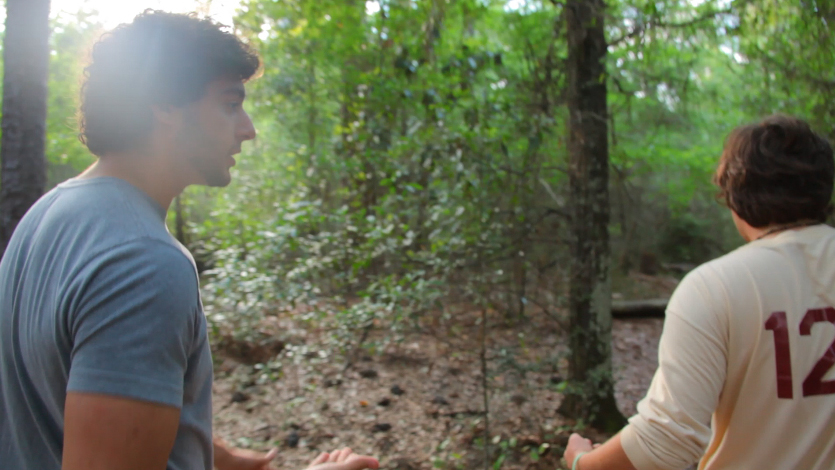
Johnnie Walker - Dear Brother
This is a spec advertisement that is currently breaking the internet in my social circles. I'm sharing here for two reasons.
- This piece can only be described as heartbreakingly beautiful. Stunningly shot, edited and voiced. As a piece of visual art, it is a masterpiece for these filmmakers.
- It's still bringing tears to my eyes and it's been 12 hours since my first viewing.
This is a spec advertisement that is currently breaking the internet in my social circles. I'm sharing here for two reasons.
- This piece can only be described as heartbreakingly beautiful. Stunningly shot, edited and voiced. As a piece of visual art, it is a masterpiece for these filmmakers.
- It's still bringing tears to my eyes and it's been 12 hours since my first viewing.
Walking the roads of our youth
Through the land of our childhood, our home, and our truth
Be near me, guide me, always stay beside me
So I can be free
Free
Let’s roam this place, familiar and vast
Our playground of green frames our past
We were wondrous
Never lost
Always home
When every place was fenceless
And time was endless
Our ways were always the same
Call my demons and walk me, my brother
Until our roads lead us away from each other
And if your heart’s full of sorrow, keep walking
Don’t rest
And promise me from heart to chest to never let your memories die
Never
I will always be alive and by your side
In your mind
I’m free
Pensacola's Proposed Commercial Film Ordinance
The ordinance, stated in Sec. 7-12-2 as applicable to "all parks, streets, sidewalks and other rights-of-way, parking lots, buildings, and the grounds adjacent thereto," and going on in Sec. 7-12-3 to say that "no person shall film, digitally record, or take still photographs on city property for commercial purposes without first applying for and obtaining a permit from the Film Commissioner" has put myself and other photo and video professionals very ill at ease.
I was up late last night writing an email to my city councilman, Mr. Larry Johnson. There is a piece of legislation coming up for a vote at the next City Council meeting that could do a lot of good and a lot of harm to the professional photography and video community here in Pensacola. PNJ Article: http://www.pnj.com/story/news/local/pensacola/2015/05/08/hayward-pensacola-film-commissioner/27017229/
Proposed Ordinance: http://philbaker.info/wp-content/uploads/2015/05/PensacolaProposedFilmOrdinance.pdf
Here is the letter I sent to Councilman Johnson in its entirety:
Councilman Johnson,
Good morning! I hope this email finds you well. I am writing to you in regard to the proposal regarding "Commercial Filming on City Property."
To preface this email, I would like to provide context on my background. I am a lifelong resident of Gulf Breeze and Pensacola. I attended Pensacola State College and the University of West Florida, graduating with a bachelors degree in Communication Arts, with an emphasis on film and telecommunications. Throughout high school and college, I photographed weddings and participated in independent film projects with other local creatives. I now work as a proud member of Mark Lee's real estate team at Levin-Rinke Resort Realty, and still make time to photograph weddings, portraits and editorial photography, as well as assist with independent films for creative enjoyment.
I saw the recent news that Mayor Hayward will most likely be taking on a new responsibility as the City of Pensacola Film Commissioner. That is exciting, as I believe the Greater Pensacola Area has much to offer as a location for film, television and music video production. My enthusiasm increased when I read the council memorandum evoking memories of "Wings of Eagles," "Jaws" and "An Officer and A Gentleman" to help spur Pensacola on to claim its place as an active part of the film industry in the near future. With that said, my enthusiasm waned when I saw that the definition of "commercial filming and photography" in Chapter 7-12 was left extremely vague.
The ordinance, stated in Sec. 7-12-2 as applicable to "all parks, streets, sidewalks and other rights-of-way, parking lots, buildings, and the grounds adjacent thereto," and going on in Sec. 7-12-3 to say that "no person shall film, digitally record, or take still photographs on city property for commercial purposes without first applying for and obtaining a permit from the Film Commissioner" has put myself and other photo and video professionals very ill at ease.
Most wedding and editorial photographers in this area, myself included, rely on easy and free access to city streets and parks to capture photographs and video of both local and destination weddings in downtown Pensacola. Use of city parks like Seville Square, Plaza Ferdinand, Plaza De Luna, and even the city streets themselves (on calm days) is standard practice among local photographers and videographers. The results of such common practices have been nothing but beautiful imagery of Pensacola and its people circulating on the internet and in wedding and lifestyle magazines across the country. The same can be said of local professional videographers who shoot their own stock footage of this beautiful city in order to better edit commercial pieces for local businesses.
In its current form, the proposed ordinance is terrifying for these aforementioned creative professionals. As of today (May 11th), no details have been given on possible permit costs, how frequently they will need to be applied for and what criteria will need to be met for approval. It is also not yet clear how soon the ordinance will be implemented if it passes the May 14th vote in its current form. As you can imagine, this many lingering questions has many in the local photographic community very concerned.
I fully appreciate the need to regulate large productions that require the use of equipment trucks, tents on city property, drone flights, use of city utilities and the coordination of large equipment in public areas, and I firmly believe that my peers in photography and video do as well. With that said, there is a great difference between large-scale productions involving multiple people and large equipment versus an individual videographer, wedding or portrait photographer with a single camera.
Without a more specific definition for "commercial photography" and allowances made for the photographers and videographers who already rely on free access to city parks and streets for the events they shoot every weekend, this ordinance could cripple dozens of going concerns that add value to our community at large. Local, long-time photographers like Jeremy Cook, Rick Schamberger, David and Jessica Marshall and Josh and Sara Thurber all come to mind, just to name a few. Their bodies of work are more than a means to their own living. Their images help define Pensacola far and wide as a beautiful place. The same can be said of the numerous video production companies who have, until now, freely shot their B-roll footage in public spaces for use in local commercials.
Ultimately, I hope that you will oppose this ordinance in its current form. Before it comes to the table, I would ask you to please, if you have not done so already, look at some alternative models that could be incorporated into a new draftof the ordinance for a vote. The City of New York has a very solid system in place, the details of which you can find here:http://www.nyc.gov/html/film/html/permits/permit_required_fee.shtml. In short, the system they have in place has a very accommodating set of rules stating a permit is not required when "hand-held cameras or tripods are used and the person filming does not assert exclusive use of City property." This exception has allowed for individuals and small businesses to thrive in New York City while still nurturing a profitable and active film industry under the purview of the city's film commission. Closer to home, the City of Tallahassee has a near-identical set of rules that you may find here: http://www.visittallahassee.com/industry/media-film/
It is my sincere hope that Pensacola could look to those above two cities and adopt a similar model to the benefit of all concerned.
I am writing to you, my District 4 Councilman, in hopes that you will take these thoughts into consideration as this ordinance approaches the vote.
In summary, I believe that reviving the film commission is a tremendous boon to our community, and I believe that Mayor Hayward's active and dynamic personality will utilize the potential of that position to its highest extent. With that said, the current, broad definitions and requirements pertaining to commercial photography and video are toxic to the photographic and video professionals already working hard in our city. As a voter and as a photographic professional, I ask that you oppose the ordinance in its current form and urge the rest of the City Council to do the same.
All the best, Steven Gray East Pensacola Heights, Pensacola 850-712-5730 stevengrayphotography.com
Musing on Culture: The Adaptation Problem
 The first trailer for Baz Luhrmann’s adaptation of F. Scott Fitzgerald’ novel The Great Gatsby hit the internet last year. As might be expected of a Baz Lurhmann film, bright colors and elaborate set design swirl into a cinematic cornucopia very much in the vein of Moulin Rouge.
The first trailer for Baz Luhrmann’s adaptation of F. Scott Fitzgerald’ novel The Great Gatsby hit the internet last year. As might be expected of a Baz Lurhmann film, bright colors and elaborate set design swirl into a cinematic cornucopia very much in the vein of Moulin Rouge.
Link: "The Great Gatsby" Trailer
I haven’t seen many of the films in Luhrmann’s oeuvre. I did see Moulin Rouge and did not care for it, but that alone does not prejudice me against Luhrmann as a filmmaker. His films are unique and suit some tastes more than others. The initial news that Luhrmann would be directing the latest adaptation of The Great Gatsby sparked concern among fans of both the novel and its previous Hollywood adaption.
This concern is the same worry that plagues every film based on a well-loved piece of literature: will it do justice to the book?
I dearly love F. Scott Fitgerald’s original novel, but my life is a little too busy for me to devote too much time to obsessing over book-to-screen fidelity. Less than moved by the trailer; I filed it away in the “will watch, if on Netflix Instant” file part of my mind. Then I saw an article in my RSS feed, and it started a train of thought that I wanted to indulge here.
 The article was “New Great Gatsby, On the Road Adaptations Revive an Old Debate: Can Great Books Make Great Movies?” and it used the forthcoming Gatsby and On the Road adaptations as vehicles to discuss whether or not great novels can always be adapted into great movies. The article even pulled out the heavy artillery with a lengthy Stanley Kubrick quote before ultimately pulling its punch and closing with a question instead of a resolution. The question is nonetheless a valid one. Can great books be fairly treated as films?
The article was “New Great Gatsby, On the Road Adaptations Revive an Old Debate: Can Great Books Make Great Movies?” and it used the forthcoming Gatsby and On the Road adaptations as vehicles to discuss whether or not great novels can always be adapted into great movies. The article even pulled out the heavy artillery with a lengthy Stanley Kubrick quote before ultimately pulling its punch and closing with a question instead of a resolution. The question is nonetheless a valid one. Can great books be fairly treated as films?
I have my own favorite Stanley Kubrick quote on this subject: "If it can be written or thought, it can be filmed." However, the point I want to make in this week's major blog is that it isn't simply the quality of the story which determines the ultimate quality of a film--the original format of the story is also a catalytic element for a film's success.
Today, I am making the case that good books never make good films, because only good films are good films. Books can be adapted into screenplays, but the for the film to be judged fairly, it must be judged on its own merits, before its relationship to the source material is taken into account. I contend that it is categorically impossible for any adaptation to be wholly faithful to its source material. Read on.
 Making the leap from page to projection.
Making the leap from page to projection.
It does not matter if a book is “great,” or even well-known, because the process of screenwriting requires specific changes to be made in the adaptation of any source material. To establish this, I will offer an extremely well-known series of adaptations as a first example: The Lord of the Rings trilogy, written by J. R. R. Tolkien and adapted for the screen by Fran Walsh, Philippa Boyens and director Peter Jackson.
The original Lord of the Rings novels are extremely detailed. Tolkien went to unprecedented lengths to flesh out the world of his stories, designing entire original languages, histories and geographies. Producers were faced with the two basic choices which must be decided whenever any book is to be adapted:
- Preserve the intricacy of the source material by tasking a group of screenwriters to adapt each novel into a six-hour miniseries.
- Create a less expensive, wider-reaching product by condensing each novel into its own two-hour feature film.
In the case of The Lord of the Rings, it is well known which option the producers took. Detail was undeniably sacrificed in the adaptation process, but consensus among fans is that the films stayed true to the spirit of Tolkien’s novels, even if certain elements were omitted or rearranged for clarity in visual storytelling (more on that later).
The Lord of the Rings was a rare series of adaptations, because the three films not only presented the individual personalities of Tolkien’s many characters, but the themes of the novels remained intact throughout. Themes and characters wage war with each other for audiences' attention, and to that point we will now focus our attention.
Themes are important.
Without a theme--a “grander purpose” as it were, audiences have no reason to watch characters on a screen. Even films and television shows discussed as “character studies” are only successful as such because of the themes explored in the nature of their characters. In the case of a show like Mad Men, the central character of Don Draper is rarely a likable individual. The omniscient audience is privy to every lie he weaves between his personal and professional lives, and are even given the upper hand through flashbacks that show how Don Draper literally became Don Draper. However, despite being unscrupulous and often very cruel, Draper succeeds as a character, because the writers of Mad Men use him to explore very real issues of man’s search for identity and fulfillment.
Even in films or programs like Mad Men which are categorized as "character studies," the actions of characters, however entertaining, are completely meaningless unless they speak to a finer point, a theme. As one more example, let’s briefly look at Spike Lee’s Do the Right Thing.
 Do the Right Thing has very few characters who are endearing for their own sake. However, Lee’s characters exist for a reason beyond their own stories. The blacks, Italians, Puerto Ricans and Asians populating Bed-Stuy in Do the Right Thing are not true individuals in the eyes of the screenplay--they are microcosms of entire populations. By writing characters with no significance as individuals, but who expressed the unique rages of entire demographics, Lee's film communicates the realities of modern racism with incredible force.
Do the Right Thing has very few characters who are endearing for their own sake. However, Lee’s characters exist for a reason beyond their own stories. The blacks, Italians, Puerto Ricans and Asians populating Bed-Stuy in Do the Right Thing are not true individuals in the eyes of the screenplay--they are microcosms of entire populations. By writing characters with no significance as individuals, but who expressed the unique rages of entire demographics, Lee's film communicates the realities of modern racism with incredible force.
Strong stories necessitate strong characters, however unlikable they are. However, one cannot expect the same success when the order is reversed.
When a character’s individual significance is given precedence over their place as part of the film as a whole, this is often indicative of a story which lacks a truly compelling theme. If the viewer of a film is led to care more about character more than the story itself, chances are that they are watching a story which is not written to have any real significance.
In continuing our examination of characters and themes, let us look at them in the light of the writing process. It is important to understand the differences between stories written for print and stories written for film.
We will return to the idea of characters versus story in a moment, but before we do we must understand how these stories are written in the first place.
 The world of difference between writing for print and writing for cinema.
The world of difference between writing for print and writing for cinema.
In a novel or original screenplay, it is perfectly alright for characters to dominate over theme. Different kinds of stories cater to different audiences' tastes. If a film or a novel is only worth attention because it is simple, light entertainment, it is no less a legitimate work of fiction than if it is built on heavily wrought themes which are woven around every challenge of the human experience.
The problems occur when a story written for one medium (print publication) is retrofitted to the storytelling style of another (film).
Writing a story for print is a much freer process than writing for film. A novel can be as short or as long as is necessary to fully tell its story. It can be traditionally structured or spontaneous and associative in the ways in which its story unfolds for the reader. According to the story’s needs, the people, places and things within a story can be drawn in near-infinite detail. Until the story is offered to the mercies of an editor, the novelist reigns as a supreme deity over how his or her story is told. That is the freedom of written fiction.
Contrast this with the process and limitations of screenwriting, and its place in the collaborative business of filmmaking. Screenwriters do not create descriptively-written worlds which readers can interpret mentally; The delivery of a screenplay is not a direct transfer from page to mind, it is moderated by a team of artists and technicians who take it upon themselves to interpret the story and guide the viewer through in the way they deem proper. The screenplay is treated as nothing more than a working template with dialog for the actors.
 Furthermore, the stories themselves are constricted in their writing by the confinement of time. No matter how much time passes within the context of a screenplay's story, and no matter how many characters it contains, the screenplay must be written so that its final, visual interpretation will not exceed a running time between ninety minutes and two hours.
Furthermore, the stories themselves are constricted in their writing by the confinement of time. No matter how much time passes within the context of a screenplay's story, and no matter how many characters it contains, the screenplay must be written so that its final, visual interpretation will not exceed a running time between ninety minutes and two hours.
Filmmaking is a business, and it must move efficiently to turn a profit. For production teams and actors to digest a story and commit it to film in a timely manner, screenwriters most often reduce the characters’ actions and thoughts to the simplest possible terms. This changes the very language of writing, and is what truly separates screenwriting from novel-writing as a distinct writing style. Consider the following example:
In a story about a hard boiled detective, the novelist might write:
Sam reached into his jacket pocket and took out the cigarette lighter his dad had given him as a kid, just for kicks on a Saturday. ‘Don’t tell your mom,’ dad had said with a grin. Now, the lighter was cold in Sam’s hand, but grew warm as he struck the light and ignited the unfiltered Marlboro between his lips. The lighter was warm, just like the bullet that popped his dad’s heart like a balloon the day after he gave Sam the lighter.
By contrast, screenwriting requires that the same action be expressed much more economically:
Sam takes his lighter out of his pocket and lights a cigarette.
A world of difference, wouldn't you agree?
Novels are hot rods, adaptations are station wagons.
Even though it is obvious that the styles of writing for print and writing for film are markedly different, that does not mean that one is less effective than the other. The problems arise when the infinite nuances of a well-written novel are pared down and re-written to be communicated visually.
A screenwriter faces a weighty problem in adapting a beloved story. There is never, ever enough time in even a two-hour film to include ever detail of a book. And, ultimately, it is the fans of the source material who hold all the cards. They know every twist of the plot, every motivation of the characters, and as a coup d'grace to the screenwriter's difficulties, every reader has seen it differently in his or her own mind.
The hairiness of the situation is made even worse by the ten-figure sums which are spent on major films. The film needs to please the fans, but every fan wants to see their own personal envisioning of the story, because anything else would be, like, totally lame.
This is the fundamental, aphoristic difference between novels and screenplays: novels are written for the theatre of the individual mind, and screenplays are written for mass exhibition via technical processes. Novels are written with a level of detail that literally cannot be expressed through the work of a camera. For a book to work at all as a film, it must be reduced.
Ultimately, most adaptations usually fall into one of the following three categories
- Mechanical movement through many plot points as possible, usually at the expense of emotion and depth of character. (Harry Potter, The Hunger Games)
- Abstract interpretation of theme which leaves the original story barely recognizable. (Apocalypse Now)
- Glorification of the characters over their story. (The Big Sleep, Fight Club)
Every adaptation must begin with the screenwriter's painstaking selection of the original story's "structural supports;" most integral parts of a story. Only when these have been established into a workable script can the screenwriter go back and add in as many of the extra details as will fit within the film's running time.
All too often, many of these so desired-for details are still deemed superfluous by studio executives and left out of the theatrical edit, being inserted back into the a "directors cut" at a much later date as "extra character moments for the fans." This, I suppose, is the only consolation some screenwriters will have after the perceived lack of effort on their part has already earned them the ire of their project's original fandom.
After Lord of the Rings, The Hunger Games, Harry Potter, Eragon, Twilight, The Da Vinci Code and innumerable other novels being adapted into films of lesser strength than their original novels, one would assume that book fans would have learned to not expect perfect fidelity from Hollywood; but the old indignant response continues to greet every film.
Coming full circle.
Referencing the Open Culture article from earlier, the question asked was “Can Great Books Make Great Movies?”
At the end of this piece, here is my answer: No book can ever make a good movie. Good movies make good movies.
If a movie is based on a book, book fans need to recognize and fairly acknowledge that novelists write novels, screenwriters write films. When the limitless scope of novel is shoehorned into the limitations imposed by cinematic storytelling, there will be loss in translation.
I love books. I appreciate and respect the time, thought and loving care which good (and even bad) authors impart to their work. Stories always begin with a mind, and even films and music begin in the minds of writers. In a sense, writers are progenitors of every culture.
But that does not diminish the respect which I have for the work done by filmmakers. Good filmmaking is the result of a year of collaboration between writers, directors, performers, artists, designers, caterers and enthusiastic gophers.
When an adapted film judged harshly and angrily criticized simply on the basis of its differences from the source material, book fans make a grave and very unfair mistake: in their rush defend the work of a single author, they fail to realize that what they are really doing is demeaning the honest and hard work of the hundreds of people who took as much as a year out of their lives to bring a book to visual life.
In closing...
Coming back to the subject of The Great Gatsby, I suggest that fans of the original book (like myself) acknowledge here and now that the direction of Baz Lurhmann and the acting style of Leonardo DiCaprio will most likely not capture the full depth and pathos of Jay Gatsby as originally written written by F. Scott Fitzgerald. Speaking editorially, I personally believe that Tobey Maguire is dead weight whenever onscreen and will likely not help the film's cause among book fans.
However, Baz Luhrmann’s lush visual style is quite appropriate for presenting the opulence and excess of New England’s upper class during the Roaring Twenties. Leonardo DiCaprio has also become adept at playing brooding characters whom life has left feeling hollow. Between these two elements, it is more than a slightly possibility that the film will fairly present a strong interpretation F. Scott Fitzgerald's theme of a man searching for meaning in a culture which does not value substance as much as it does style.
It is quite possible that I will love Luhrmann's The Great Gatsby as much as I love Fitzgerald's The Great Gatsby--I will simply appreciate them in different ways.
"Dark Shadows" and the need for a moral center.
 A few nights ago, I went with my sister to see the latest Tim Burton/Johnny Depp film, Dark Shadows. I am completely unfamiliar with the television show which inspired the movie, but as a film it was watchable enough. However, there was one serious drawback which prevented it from being a movie in which I could truly feel engaged: the main character was totally devoid of a moral center.
A few nights ago, I went with my sister to see the latest Tim Burton/Johnny Depp film, Dark Shadows. I am completely unfamiliar with the television show which inspired the movie, but as a film it was watchable enough. However, there was one serious drawback which prevented it from being a movie in which I could truly feel engaged: the main character was totally devoid of a moral center.
The word "moral" is a problematic one to use in an entertainment critique, because virtually every reader will have his or her own personal meaning attached to it. For the purposes of this post, when I say moral, I am not restricting the paradigm to a set of religious precepts, i.e., "that's immoral," I am talking more about the code of ethics ascribed to by the characters within the film.
Screenplays are constructed out of several ubiquitous elements: story, scenes, characters, themes, etcetera. Characters are established and they play out a story. The nuances of a story move from scene to scene along the plot. The quality of a screenplay is judged on how effectively its story and the concomitant plot provide motivation for the characters to behave the way they do. Well-written screenplays are built on foundational themes which the plot deals with in a meaningful way. The completed story is the cumulative result of characters' actions and interactions as dictated by the plot.
For a story to "work," the characters need a personal journey within the broader scope of the story: an arc. This could be a villain's transformation into a hero (or vice versa), or a character's discovery of just who murdered his parents in the dark alley all those years ago. It is much easier to sympathize with principle characters when the audience makes discoveries about the world of the film with them. That allows for sympathy (and on a subliminal level, trust) to be established between the audience and the protagonist.
Naturally, the plot is greatly strengthened when characters' actions make sense. When a character's actions contradict the arc established for them in the eyes of the audience, it creates aggravating dissonance. Some screenplays can introduce dissonance and resolve it by the time the credits roll, using it to effectively maintain audience interest. This is not the case with Dark Shadows.
The story's setup is straightforward. The principal character of this film is Barnabas Collins. He is played by Johnny Depp with all of the familiar quirks and tics which characterize a Depp performance under Tim Burton's direction. Barnabas has a tryst with a maid named Angelique (Eva Green), but falls in "true love" with Josette Du Pres (Bella Heathcote). Sadly for Barnabas, Angelique moonlights as a witch, and through her dark arts she kills both Josette and Barnabas's parents, and condemns Barnabas to eternal damnation as a vampire. Two hundred years later, ("197, to be exact"), Barnabas is unearthed and released from his chain-wrapped coffin by a construction crew. He sucks them all dry of sangre, seeks out his descendants, resurrects the family business and adjusts to life in the oh-so-groovy 1970s. As the film's antagonist, Angelique also preserved herself until the present day, keeping her lipstick fresh and her smile inviting should Barnabas return.
These plot points set up Dark Shadows to revolve around themes which are easily digestible for anyone who has seen one or more vampire films. Dark Shadows references lost love, enduring love, conflicted love and the double-edged sword of immortality. The "fish out of water" concept is thrown in for comedic relief as the Georgian Barnabas confronts modern elements from hippies to a lava lamp. But once the introductions and fun moments have been exhausted, the screenplay is lacking in several critical areas.
The largest flaw in the screenplay is in the characterization of Barnabas himself. Barnabas is the protagonist; the audience needs to sympathize with him and are given cues to do so by several of his character traits. He is lovelorn and spiritually damned, but he avoids self-pity and is committed to helping his family. After revitalizing the family business, he even manages to score Alice Cooper as the entertainment for a town-wide soiree. His characterization as a sympathetic figure is almost compelling, except for one thing.
Barnabas is an amoral sociopath.
While Barnabas' relationship to his family is noble and his relationship to the modern world humorous, his charisma ends there. Whether out of an unclear character study on the part of the screenwriter or a misguided subservience to more prevalent vampire lore, Barnabas is never fully developed into a quirky Burton protagonist. Too often, his persona collapses into yet another interpretation of Dracula (or even Count Orlok). In just the events shown onscreen, Barnabas commits at least two acts of mass murder, murders a principle character and dumps the body in the ocean, and uninhibitedly hypnotizes friend and foe alike to get what he wants.
Dark Shadows pays homage to a long-standing theme of all vampire films and literature, which is the vampire's attempt to reclaim a lost lover by winning the heart of their modern reincarnation. In this case, Josette is reincarnated as the modern-day Victoria Winters, the Collins' family governess. But before pursuing her, his self-proclaimed "true love," Barnabas soullessly and senseless engages in another night of loveless passion with Angelique. Their lovemaking scene is a masterpiece of wire-fu stuntwork, but is simply at odds with literally everything else which is said about the love triangle between Barnabas, Angelique and Victoria/Josette. A scene of this nature, thus unmotivated, cheapens all of Barnabas's further expressions of love toward Victoria, including the film's final scene.
To complete his lack of ethics, Barnabas speaks constantly of vampirism as a curse, even going so far as to attempt a cure. But this is undermined by his total lack of remorse for any and all of his conscienceless actions. Most of the time, no matter what he might say, he seems to take great pleasure in the abilities and mores germane to vampires.
For a film to work, the audience needs to care about the protagonist. But for an audience to care, they need to understand. Barnabas cannot be understood, because his actions condemn his dialog to being a string of non sequiturs.
Efforts to humanize Barnabas through comedic foibles and bursts of filial devotion are undercut by the fact that, at his core, Barnabas is a very selfish individual with no true convictions. If one takes into account that he dabbled in the occult himself before being made a vampire, there is little or no difference between Barnabas and Angelique, only in their respective goals.
When too many similarities exist between the protagonist and antagonist in a story, a writer or director has to dispel them for clarity or explore them for drama. Neither happens in Dark Shadows. In the end, the audience is left with a mildly entertaining film containing scattered moments of comedic dexterity and comfortable retreads of familiar Tim Burton motifs. But the story fails on a structural level.
Instead of laughing and crying along with a compelling and quirky character, like Barnabas Collins could have and should have been, I found myself watching his numerous illogical decisions with impassive detachment.
Film is a visual medium, and the old adage "actions speak louder than words" is never more true than in cinema.
External Links:
Writing with Hitchcock: Plot vs. Story in Alfred Hitchcock'sVertigo - YouTube
Diffused Light
My teammates and I shot our final project for our film practicum yesterday. We shot it on my 5D MkII and had a great time.
The picture quality out of my Canon 5D MkII never ceases to astound me. Despite its recently being eclipsed by the 5D and the new line of 1Ds, but it still stands as a revolutionary tool in the world of independent filmmaking. The stills below are taken from the footage as it came out of the camera.
We shot late in the afternoon, and between the low angle of the sun and the concurrent diffusion from the tree canopy at the late hour, the lighting we had to work with was absolutely gorgeous. We used no light modification whatsoever, and I love the way it looks.
Whenever I get tired or burned out in image-making, days like yesterday revive my creative spirit and make me very excited to have such a wonderful environment in which to work. It just makes me sad that the projector in our classroom will degrade the footage as much as it always does.






















